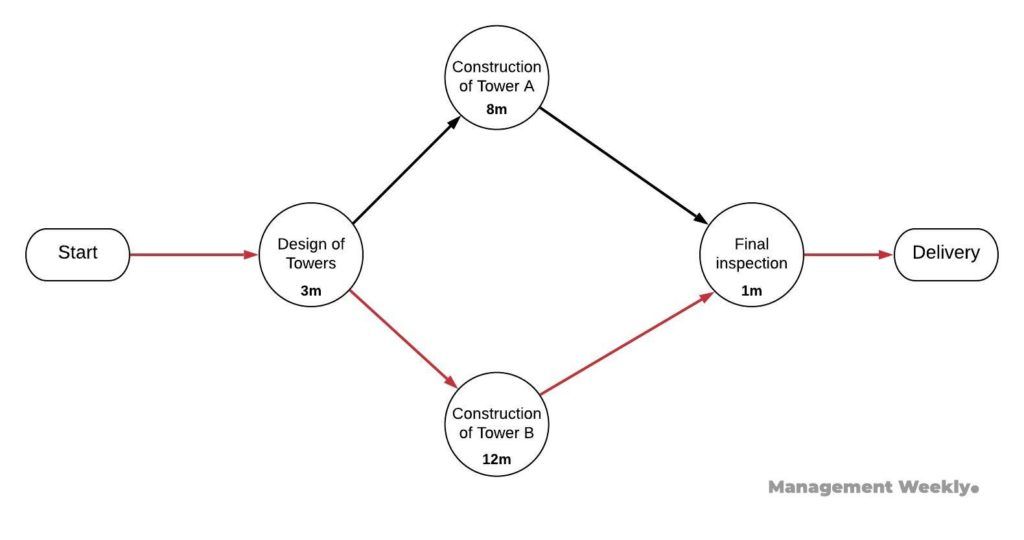Critical Path Analysis is also known as the Critical Path Method (CPM). We shall also look at a Critical Path Method example to highlight this tool. We use this tool in project management to ensure timely completion of the project.
Contents
Origins of the Critical Path Method
The critical path method traces its origin to the chemical company DuPont. In 1956 DuPont entered into a joint venture with the computer company Remington Rand Univac. They developed the Critical Path Method. We use this to understand the relationship between different activities of a project. Another similar concept is the arrow diagram for the tasks.
They developed the stool to understand how the activities affect the project timeline. They used the UNIVAC-1 computer to program and test this new method. Consequently, they used it for the deployment and decommissioning of different plants of the DuPont corporation.

What are the advantages of CPM?
There are several advantages to the CPM. We shall see some of the most common advantages of the critical path analysis:
- Critical path analysis helps us ascertain the minimum and maximum time that a project can take.
- CPM helps in the timely completion of projects.
- It also shows a visual representation of the entire project activities.
- It gives us the details of all the activities and the schedules that need to be met for these.
Critical Path Method overview
- Enlist all the activities of the project
- Ascertain the sequence of the activities.
- Also, mark the activities that need to be done sequentially.
- Subsequently, we mark the activities that could be done parallelly.
- Represent the activities in the form of the network diagram.
- Name each activity as an alphabet. We should mark the alphabets sequentially to avoid confusion.
- Draw the 7 box figure for each activity.
- Next will list the early start and early finish as well as the duration for each of these activities.
- Once this process is done we will retrace the parts backward.
- While reducing the path backward we will look into the late finish and late start times.
- Meanwhile, we will also write down the slack time for each of these activities.
- Thereby we complete the entire CPM diagram.
A simple example to highlight the chain of activities
Let us consider a very simple process. Let’s take the example of applying for a job. We know that even this simple ‘project’ has many small activities. However, let’s look at a very simplified version of this process. This should give us an understanding of the concept of the activity chain.
Firstly, you need to find appropriate jobs.
Secondly, you need to to evaluate the job description.
Thirdly, you to make a checklist of all the required documents to apply.
You attach the required documents and send it to the recruiter.
In the most basic sense, the total time that would be required to apply would be the sum total of all these activities. However, the real-life situation is generally more complex. Also, there will be several tasks that ‘need to be’ or ‘can be done’ in parallel. This requires a proper method to estimate the required time.
Further thoughts
When we look at real-life project examples, then there is no certainty of completion. You would have a range of time for each activity. They would be optimistic estimates for the time. Additionally, you would also have a pessimistic estimate of the time. The minimum amount of time to complete a task is an optimistic estimate. On the other hand, the presence of the customer is the maximum time it would take to complete the task.
Additionally, when there is a sequence of activities they have interdependence on each other. In simple words, you would also have an early start time for each activity and late start time. Early start time would be applicable when the earlier tasks have been completed on time.
On the other hand a late start time would be applicable when the previous tasks have not been completed on time.
Critical Path Analysis definition
What are the supreme source of knowledge in project management is the Project Management Book of Knowledge. This is also known as the PMBOK.
“The Critical Path Method is the sequence of scheduled activities that determine the duration of the project”
PMBOK (Project Management Book of Knowledge)
Understanding CPM or CPA intuitively
The maximum amount of time that a project can take would depend on the longest chain of activities. for instance, the latest consider a very simplified construction project.
We can see that we can divide the entire process into two different paths. The longest path is the one on the bottom. In this project, the construction for both the towers can be done simultaneously as seen in this diagram. However, Tower A will take 8 months while Tower B will take 12 months. Also, the inspection can be started only when both towers are ready.
Therefore, the total time taken for the completion would be driven by the second path. This second path is called the critical path. We can see that it is marked in red. Therefore, we can say that the project will be completed in a minimum of 3+12+1= 16 months.

Critical Path Method Example
Critical path method: check out this very well illustrated Critical Path Method Example. It is shared on Youtube by iZenBridge Consultancy Pvt Ltd. You can watch the video below:
Action steps after doing CPM
Once you find the critical tasks you can work upon them. Once the Critical Path Analysis is done, the manager can work upon certain areas. Usually, the bottlenecks of the project. Managers ensure timely completion of the bottleneck tasks. Any delay in the critical activities means a delay for the entire project.
Secondly, you can deploy more resources to complete the critical tasks.
Thirdly, you can restructure the set of activities to ensure that the constraint is lifted.
Critical Path Method: Example of managerial actions
We have already discussed the importance of finding critical tasks. The operations manager can ensure the availability of resources for the completion of these tasks on time.
Now let’s see at some of the other works of the operations manager:
Ensuring timely completion
The project manager can shorten the time duration for the project by managing some of the important constraints. Firstly, they need to assess which activities have got slack. Secondly, they need to look at ways of meeting the deadline.
Those tasks that big that can be done parallelly, need to be scheduled on parallel paths. If you reduced the slack, project timelines can be compressed.
Resource balancing
Additionally, certain tasks that take more time can also be done faster. This is known as crashing. Usually, this involves deploying more resources to complete the same task. However, not all tasks can be crashed. Secondly, it could hamper the quality of the work. In these cases, there is an alternative strategy.
We can overcome the bottlenecks through the balancing of resources. This is also known as resource-leveling. However, this could change the critical path. Thereby it will lead to a new critical path for the project.
Some of the drawbacks of Critical Path Method
Critical Path Method does not take into account a lot of factors that could hamper the schedule of the project.
Firstly, it is difficult to estimate the impact of human resources. Secondly, certain activities cannot be estimated beforehand. Thereby making CPM very difficult. Thirdly, critical path analysis can be very complicated for big projects that are comprehensive.
It also does not talk about the remedial steps in case the project gets delayed.
Every project can be thought of as a set of interdependent activities. Critical Path Analysis helps us visualize and predict the timeline of these activities.
They are same for all practical purposes.
Chemical company DuPont invented this tool along with their associate Remington Rand Univac.
